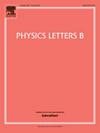Dark matter annihilation via Breit-Wigner enhancement with heavier mediator
IF 4.3
2区 物理与天体物理
Q1 ASTRONOMY & ASTROPHYSICS
引用次数: 0
Abstract
We propose a new scenario that both the dark matter freeze-out in the early Universe and its possible annihilation for indirect detection around a supermassive black hole are enhanced by a Breit-Wigner resonance. With the mediator mass larger than the total initial dark matter mass, this annihilation is almost forbidden at late times. Thus, the stringent cosmic microwave background and indirect detection constraints do not apply. However, a supermassive black hole can accelerate the dark matter particles to reactivate this resonant annihilation whose subsequent decay to photons leaves a unique signal. The running Fermi-LAT and the future COSI satellites can test this scenario.
求助全文
约1分钟内获得全文
求助全文
来源期刊

Physics Letters B
物理-物理:综合
CiteScore
9.10
自引率
6.80%
发文量
647
审稿时长
3 months
期刊介绍:
Physics Letters B ensures the rapid publication of important new results in particle physics, nuclear physics and cosmology. Specialized editors are responsible for contributions in experimental nuclear physics, theoretical nuclear physics, experimental high-energy physics, theoretical high-energy physics, and astrophysics.
 求助内容:
求助内容: 应助结果提醒方式:
应助结果提醒方式:


